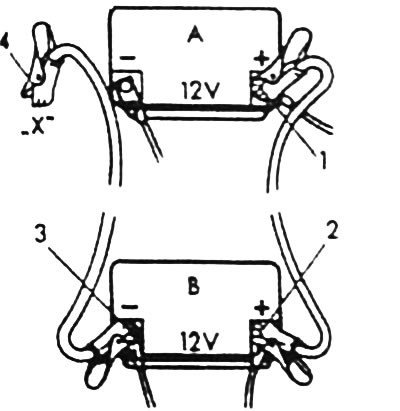Caution: If the wiring regulations are not followed exactly, there is a risk of burns due to the release of electrolyte from the battery. In addition, injury or injury may result from an exploding battery. In addition, the vehicle's electrical system may be damaged.
The cross section of the starting wire for petrol engines with a displacement of up to approximately 2.5 liters must be at least 16 mm2 (diameter approx. 5 mm). For diesel engines and gasoline engines with a displacement of more than about 2.5 liters, the cross section of the wire must be at least 25 mm2. The working volumes are indicated for a car engine with a discharged battery. The cross section of the wire is indicated, as a rule, on its packaging. When buying a new wire, it is recommended to purchase an auxiliary starter wire with insulated clamps and a section of 25 mm2, as it is also suitable for engines with smaller displacement.
Both batteries must be rated for 12V.
A discharged battery can freeze even at -10°C. A frozen battery must be thawed before connecting the auxiliary jump lead.
A discharged battery must be properly connected to the vehicle's electrical system.
Check the electrolyte level in the discharged battery, top up with distilled water if necessary.
Vehicles should be placed at a distance that excludes their contact with metal parts. Otherwise, current may flow even when the positive pole is connected.
Put both cars on the handbrake. Set the gear selector to the neutral position, in the presence of an automatic transmission, put the operating mode selector lever in position P.
Switch off all current consumers.
During the start-up process, the engine of the vehicle delivering current must be idling. This avoids possible damage to the generator due to voltage peaks during start-up.
Avoid open flames or burning cigarettes close to the battery during start-up, as combustible gases may be released from the battery.
Make sure that the auxiliary start wire is not damaged by rotating parts such as a radiator fan.

Connect auxiliary wires in the following sequence:
- 1. Red wire (+) connect to the positive pole of the discharged battery -A-.
- 2. The second end of the red wire (+) connect to the positive pole of the battery supplying current -B-.
- 3. Black wire (-) connect to the negative pole -3- of the battery supplying current.
- 4. The other end of the black wire (-) clamp -X- to connect to the body of the receiving vehicle. A metal part firmly screwed to the engine is best suited for this. Under adverse circumstances, when a wire is connected to the negative pole of a discharged battery, it may explode due to sparks and the formation of explosive gas in it.
Once again check the tightness of the connection of the terminals of the starting wires.
Attention: The terminals of the connected auxiliary start wire must not come into contact with each other, likewise, the positive terminals must not come into contact with the body parts (bodies or frames).
The engine of the receiving vehicle (with dead battery) start and leave to idle. When starting, do not keep the starter running continuously for more than 10 seconds, because the clamps and wires heat up due to the high starting current. The pause between two successive start attempts must be at least 1/2 minute.
Do not lean over the batteries - risk of burns from electrolyte!
After starting, disconnect the wires in reverse order: first disconnect the black wire (-) at the car receiving the current, and then at the car giving the current. Disconnect the red wire first from the car giving current, and then from the receiving car.
Visitor comments